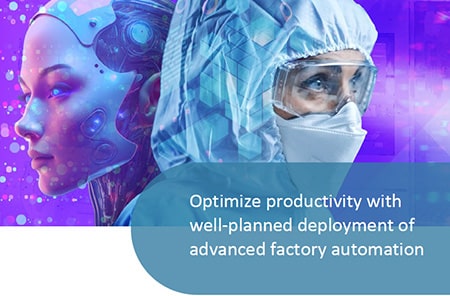In today’s semiconductor manufacturing and factory automation ecosystems, machines are smarter, software is more advanced, and data flows in every direction. Yet behind all this progress lies a surprisingly stubborn problem–configuration chaos.
Every factory asset, whether it’s a furnace, lithography tool, or automated guided vehicle (AGV), must be configured in multiple applications. This could include, for example, the manufacturing execution system, equipment automation, recipe management, advanced process control, and materials control. Each of these has its own interface, data model, and configuration process. This can lead to duplicate effort, mismatched settings, and hidden risks that quietly erode productivity.
The hidden costs of configuration chaos
Setting up a tool a few times across different systems may seem manageable, or at most a minor inconvenience. In reality, this problem scales quickly and painfully. Among the problems manufacturers experience are:
- Configuration drift: A parameter updated in one system but not another causes errors, misaligned recipes, or tool holds.
- Operational inefficiency: Engineers waste countless hours duplicating work across systems instead of optimizing processes.
- Downtime and yield loss: Misconfigurations are among the leading, hidden causes of unplanned downtime and scrap.
- Compliance risk: Auditors demand traceability, but when settings are scattered across five systems, proving control is difficult.
For a single factory, these issues can mean weeks of lost time per year. Across a network of plants, the costs multiply dramatically.
Why legacy approaches fall short
Manufacturers have tried to address this problem with custom integrations, manual workflows, or one-off scripts. Unfortunately, these approaches rarely scale, resulting in a situation where:
- Point-to-point integrations quickly become fragile, expensive to maintain, and hard to adapt when new systems are added.
- Manual updates are slow and error-prone, leaving no reliable audit trail.
- Lack of governance means no easy way to reconcile when mismatch occurs.
As factories grow more automated and connected, the stakes get higher. What’s needed isn’t more patchwork, but rather a new way to think about configurations altogether.
Introducing SmartFactory Common Config Hub
SmartFactory Common Config Hub was built specifically to address this growing need in manufacturing environments. The solution acts as a central synchronization layer that ensures every system, every tool, and every stakeholder is working from the same, harmonized configuration.
Instead of setting common parameters five times in five systems, you define them once. SmartFactory Common Config Hub propagates the configuration automatically—reliably, securely, and with full governance.
Key capabilities
- Single source of truth
One central repository for asset configurations, ensuring all connected systems are aligned. - Knowledge graph for traceability
The graph links configuration data from MES, equipment automation, recipe management, advanced process control, and materials control. This unifies configuration context across systems without the need for full data consolidation. - Automated synchronization
Changes propagate instantly across solutions. - Governance and compliance
Built-in audit trails, access controls, and policy enforcement make it easier to meet industry regulations. - Open and extensible
API-driven architecture allows easy integration with existing factory applications and future systems. - Digital twin integration
Configurations can be tied to digital representations of assets, enabling smarter analytics and AI-driven optimizations.
Benefits for manufacturers
Implementing SmartFactory Common Config Hub delivers immediate and measurable impact, including:
- Harmonization: Eliminate configuration drift and mismatches across applications.
- Faster asset onboarding: Bring new machines online in hours instead of weeks.
- Reduced downtime: Fewer misconfigurations mean fewer unexpected tool holds.
- AI-driven anomaly detection and automated validation: Detect configuration mismatches and flag inconsistent parameters.
- Audit-readiness Configuration changes are tracked, visible, and reportable.
- Empowered workforce: Engineers focus on improvement and innovation, not repetitive data entry.
Impact to factory operation
Consider a semiconductor fab adding a new lithography tool. Traditionally, engineers would need to configure the tool in MES, equipment automation, recipe management, advanced process control, and materials control separately. Each step takes hours, involves manual copying, and risks error.
With SmartFactory Common Config Hub, the configuration is defined once and automatically synchronized across all systems. In this example, the fab would have achieved:
- 70% faster onboarding of the new tool.
- 40% reduction in configuration-related errors.
- Improved audit readiness for ISO and customer compliance checks.
Ultimately, this results in faster time-to-production, higher reliability, and more productive engineers.
Laying the groundwork for smart factories
- AI-driven, self-configuring factories that adapt automatically to changes in demand or process.
- Smarter digital twins that use synchronized configurations for more accurate modeling.
- Seamless multi-factory scaling where best-practice configurations can be applied globally in minutes.
Conclusion
Configuration chaos has been negatively impacting productivity in factories for far too long, but manufacturers don’t have to accept it as inevitable. With SmartFactory Common Config Hub, they can move from duplication and drift to harmonization and efficiency. Semiconductor manufacturers can reduce errors, cut onboarding time, and enable the next wave of smart manufacturing.
It’s time to stop fighting configurations and start using them as a driver of operational excellence.


